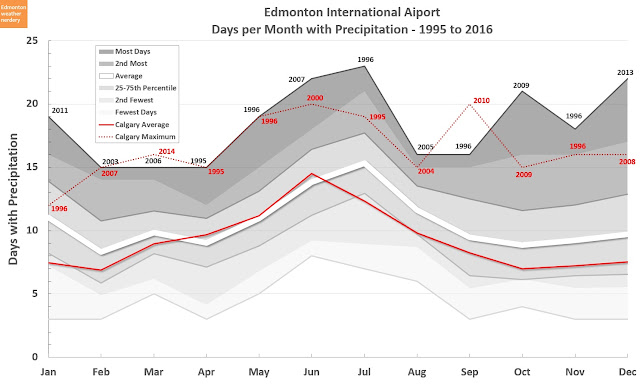A few weeks ago I did my first comparison of the two cities, which looked at the high and low temperatures throughout the year. The short version: Calgary's winter days are warmer; its winter nights are about the same; its summer days are about the same; and its summer nights are colder.
For Part 2 I had planned on digging into those temperatures a bit more, but that would have meant looking at things like days below -30°C, and that felt a little too wintery for early July. I will do that comparison eventually, but for today I think that precipitation makes more sense, since I've been looking at it a lot recently.
This will be a quick run-through of all the same charts from the past few weeks, but with Calgary data added on top. If you are curious about any of these charts, they are explained in more detail in the original posts.
For most months of the year Calgary typically has fewer days of precipitation than Edmonton. April, May and June are about the same for the two cities, but for October through February Calgary's numbers are quite a bit lower.
Even though the number of days with precipitation is different, the actual volumes are quite similar. The most notable part of this graph is when the two cities peak - Calgary's maximum is June, while Edmonton's is in July. For the rest of the year the averages are very close, although Calgary is a little bit lower in January. And Calgary apparently had a very rainy June in 2005.
Breaking things down a bit more, here are the weekly numbers:
And the weekly numbers are pretty close throughout the year, again with the exception of June and July.
On the subject of stampede, it takes place in the 1st~2nd week of July when Calgary's precipitation has dropped off quite a bit from the June maximum. In Edmonton, K-days is the 3rd~4th week July which isn't quite the rainiest week, but it's pretty close. Just based on the averages, K-days will typically get 50% more rain than stampede (although a lot of that could be evening thundershowers).
Here is how the precipitation adds up over the year. Across 12 months the averages for the two cities are almost identical. Calgary's biggest accumulation happens in June while Edmonton's is in July, which we had already seen in the monthly graph. And at least for the years from 1995-2015, Edmonton's highest year totaled 100mm more than Calgary's.
All of the charts so far have been for recent history using data from 1995-2016, but here is a comparison of the entire recorded history of the two cities:
This chart shows the snow (in equivalent mm of melted water) and the rain for the two cities. Next winter I will take a closer look at snowfall, but for now we can see that it is similar for the two cities, averaging 125mm in Edmonton and 150mm in Calgary for the last 20 years.
All the variation in the yearly data makes it hard to really compare the two cities with this chart. So here are the 5-year averages to smooth things out a bit:
A few weeks ago when I was looking at the Edmonton data I had mentioned that it was difficult to spot the 1930s drought - 1929 is low and 1930 is lower, but it recovers after that. With Calgary it is more apparent, with the average dropping down below 400mm for most of that decade. But Calgary's low precipitation during the 1930s is actually fairly typical, and is roughly the same as its numbers from 1960 all the way through 2003.
In previous posts we had also seen that since 2000 Edmonton's precipitation has dropped down from the 20th century average. Calgary is the opposite, having sat at around the 400mm/year range from the 1960s through 2003, but jumping up to the 450mm mark for the last decade. From 1970 through 2000 Edmonton had averaged about 50mm/year more than Calgary, but for the last decade the two cities have switched places.
So one of the earlier charts today showed that in the last 20 years the average yearly precipitation for Edmonton and Calgary has been almost identical. But looking more closely we see that things are a bit more complicated, with Edmonton being up for one decade and Calgary being up for the other, and the two balancing out over 20 years.







No comments:
Post a Comment